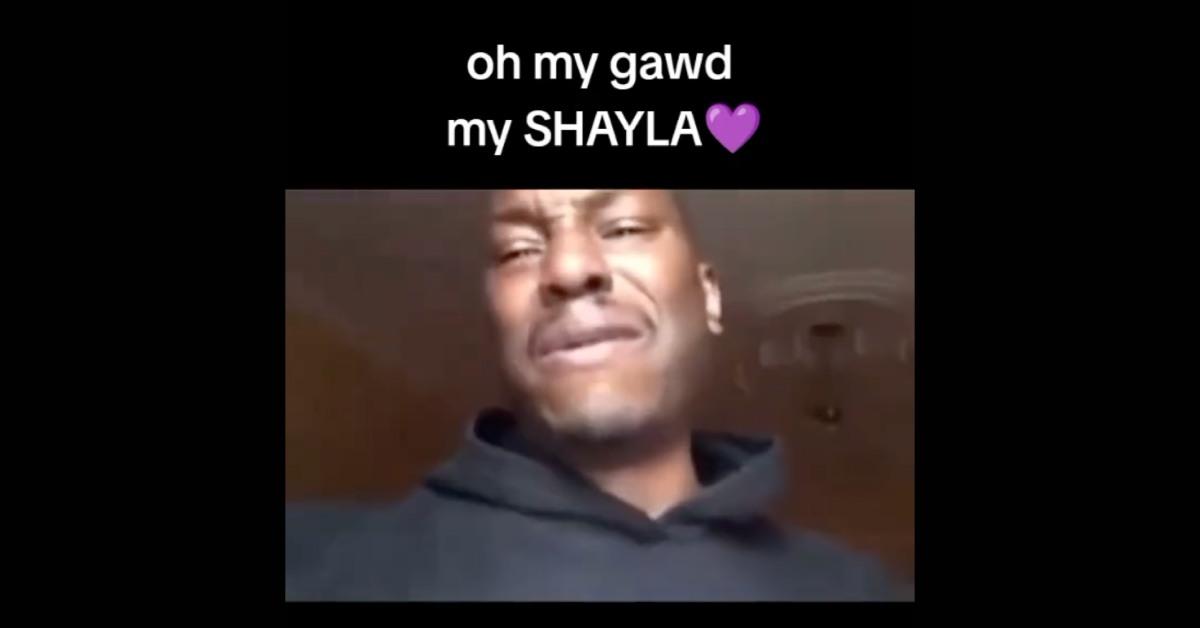Tyrese Gibson's "My Shayla" Meme: Origins & Meaning
Can a single, emotionally charged phrase capture the zeitgeist of online culture? The resounding answer, echoing through the digital halls of TikTok and beyond, is a resounding yes. "My Shayla," a snippet of raw paternal anguish, has transcended its origins as a personal plea to become a potent symbol of heartbreak, vulnerability, and the unpredictable nature of viral fame.
In 2017, the world witnessed a deeply personal moment unfold on actor Tyrese Gibson's Instagram feed. Amid a tumultuous custody battle for his daughter, Shayla, Gibson posted a tearful video plea. Raw, unfiltered, and brimming with a father's desperate love, the video quickly spread across the internet, christened with the simple yet evocative title, "Crying Tyrese." While the original video has since been deleted, its impact remains, particularly a poignant soundbite where Gibson cries out, "Oh my God, my Shayla!" This phrase, imbued with the weight of his struggle, became the unexpected seed of a viral phenomenon.
| Full Name | Tyrese Darnell Gibson |
|---|---|
| Born | December 30, 1978, Watts, Los Angeles, California, U.S. |
| Occupation | Singer, songwriter, rapper, actor, author, television producer, model, screenwriter |
| Years active | 1994present |
| Children | 2 |
| Website | https://www.tyrese.com/ |
The phrase lay relatively dormant for years, a poignant memory in the annals of internet history. Then, with the unpredictable whims of online culture, "My Shayla" resurfaced on TikTok. Detached from its original context, the soundbite took on a new life, becoming a sonic shorthand for expressing a wide spectrum of emotions. From romantic heartbreak and the sting of betrayal to everyday frustrations and the pangs of missing a beloved pet, "My Shayla" provided a universally understood audio backdrop.
TikTok users, ever adept at transforming the mundane into the extraordinary, embraced the sound with creative fervor. Videos featuring images of lost loves, broken friendships, and even humorous inconveniences flooded the platform, all set to Gibson's anguished cry. The trend highlighted TikTok's unique ability to breathe new life into existing content, reshaping its meaning and amplifying its reach to a new generation.
The resurgence of "My Shayla" speaks volumes about the cyclical nature of online trends. Content can lie dormant for years, only to be resurrected and recontextualized by a new platform or audience. This phenomenon also underscores the power of emotional resonance in the digital age. Gibson's raw vulnerability, captured in a few seconds of audio, struck a chord with millions, demonstrating that even in the often-superficial world of social media, genuine emotion can still connect us.
While some may view the trend as a trivialization of Gibson's personal struggle, it's crucial to acknowledge the multifaceted nature of internet culture. Memes, by their very nature, transform and adapt. While the original context of "My Shayla" stemmed from a painful experience, its resurgence as a meme allows it to transcend that pain, becoming a vehicle for shared emotional expression, albeit in a sometimes-ironic or humorous way. The original "Crying Tyrese" video generated memes in 2017 amid Gibson's highly publicized custody battle. The recent TikTok trend marks a second wave of virality, demonstrating the enduring power of the clip.
The story of "My Shayla" is more than just a tale of a viral soundbite. It's a testament to the evolving nature of online communication, the power of emotional connection, and the unpredictable ways in which the internet can resurrect and reshape cultural moments. It's a reminder that even in the vast digital landscape, a single phrase, charged with genuine emotion, can resonate across time and platforms, taking on new meanings and connecting us in unexpected ways. It's a raw, unfiltered cry from the heart that continues to echo through the digital world, reminding us of the shared human experience of heartbreak, loss, and even the occasional annoyance all set to the soundtrack of a father's love.
In January 2025, the term "My Shayla" experienced another surge in popularity, this time on X (formerly Twitter), following hypothetical scenarios where TikTok faced bans in certain regions. This migration further solidified the phrase's place in internet lexicon, demonstrating its adaptability and resilience in the face of shifting digital landscapes. From Instagram to TikTok, and now X, "My Shayla" continues to find new avenues for expression, proving its staying power in the ever-evolving world of online culture.
The My Shayla trend encourages users to share their own moments of vulnerability, fostering a sense of community through shared experiences of heartbreak and sadness. While the meme often takes a humorous or ironic turn, the underlying emotion remains palpable, creating a unique space for online users to connect on a deeper level. Gibson, seen in the original video wearing a black hoodie emblazoned with the words "Shayla Rocks," unwittingly provided the internet with a poignant symbol of paternal love and the struggles faced by parents navigating complex family situations.
From its origins as a raw, emotional plea to its current status as a versatile meme, the journey of "My Shayla" is a fascinating case study in the dynamics of internet culture. It's a story of heartbreak, resilience, and the unexpected ways in which a single moment can resonate across time and platforms, shaping the language of online expression.


